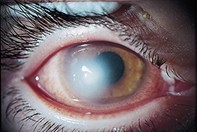Peer Reviewed
Feature Article Ophthalmology
Bacterial and viral infections of the eye
Abstract
A patient with a red eye due to infection is likely to present to his or her GP. An accurate diagnosis and prompt and appropriate treatment can be sight saving.
Key Points
- Conjunctivitis is a common cause of a red eye. Suspect bacterial conjunctivitis in any patient with bilateral sticky red eyes. A persistent conjunctivitis with a watery discharge and preauricular lymphadenopathy is most likely to be caused by adenovirus and is very contagious.
- Bacterial conjunctivitis usually responds well to topical antibiotics.
- Bacterial keratitis threatens vision and must be excluded in any patient who presents with a red eye with a corneal opacity. Contact lens wearers are at particular risk.
- Herpes simplex can cause conjunctivitis, but disease recurrence causes a keratitis with typical dendritic corneal ulcers that stain with fluorescein. Keratitis is best treated with topical aciclovir.
- Herpes zoster ophthalmicus is likely to involve the eye when the rash appears on the nose or in the medial canthus.
- Eye involvement in herpes zoster ophthalmicus requires systemic therapy with aciclovir, famciclovir or valaciclovir.
Purchase the PDF version of this article
Already a subscriber? Login here.

